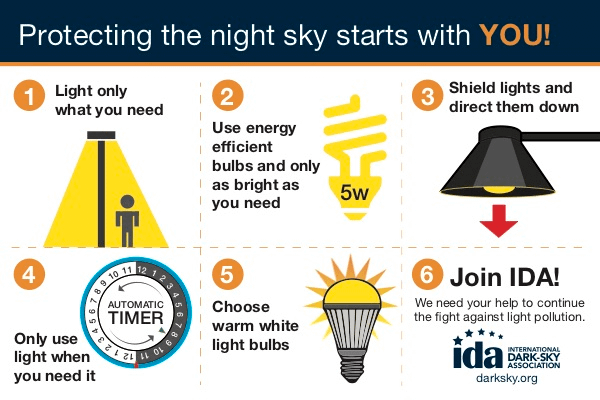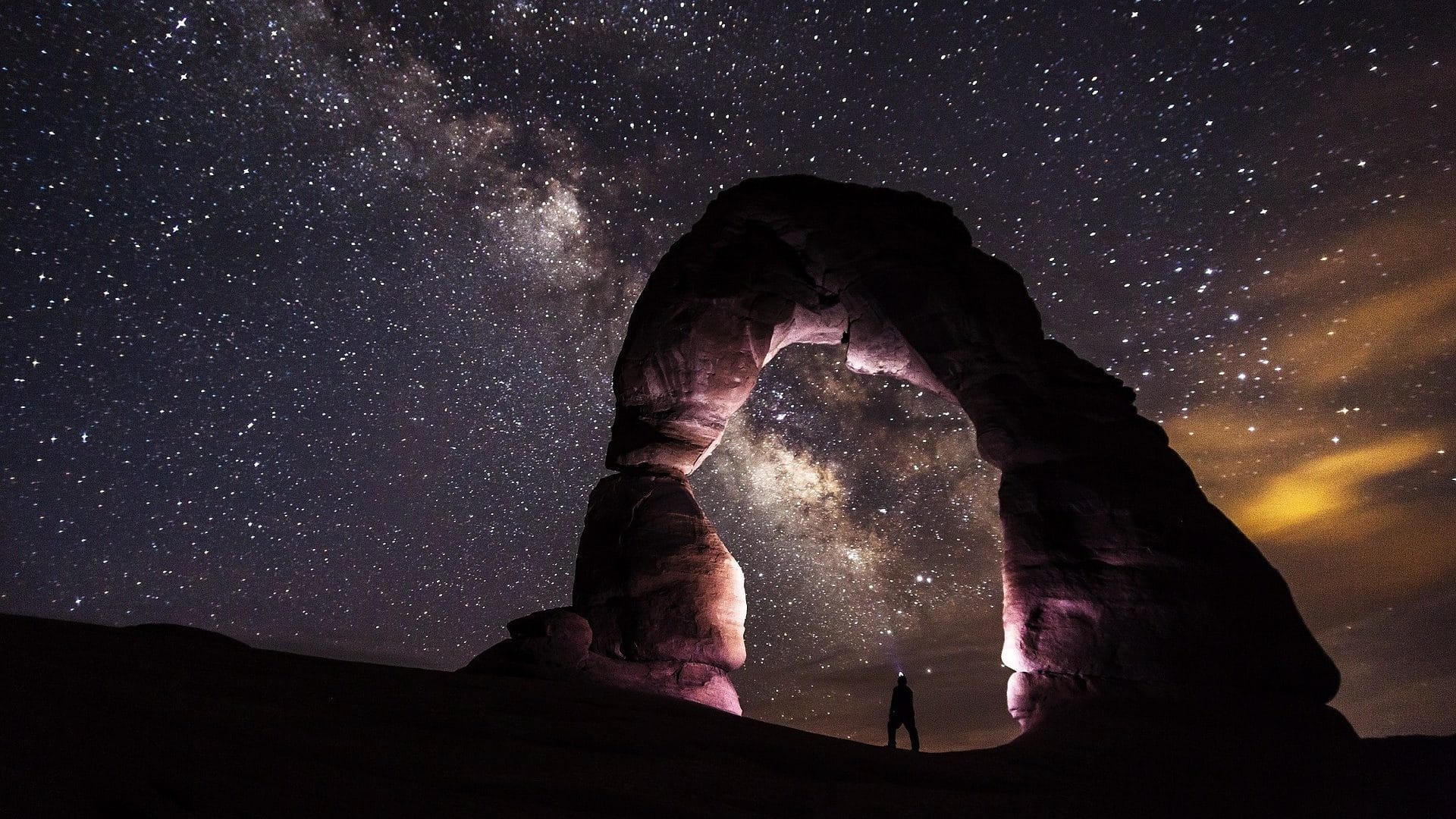This article was originally published April 28, 2019.
Did you know there is a pollution problem out there that we can fix starting tomorrow? Most of the world can’t experience the full majesty and wonder of a sky free of light pollution. Fortunately, fixing this problem is within reach and ingenious communities are already improving their health and wellbeing by restoring their night skies.
For millennia, we have used the night sky as a tool for navigation, storytelling, a source of creative, intellectual, and philosophical inspiration. On a clear night, gazing up at the night sky can be a magical experience; one that connects us to generations of humans who looked up and probably pondered many of the same questions we do.
So, what do we lose when we don’t get the opportunity to gaze into the vastness of space or lay under a blanket of stars?

Over the past 100 years, since the invention of the incandescent light, our relationship to the night sky has been inextricably changed. Like so many great things, the lightbulb made us more efficient, it improved our quality of life, and it leads us to new innovations. Unfortunately, it has had its side effects. As the prevalence of out outdoor lighting as exploded, so too has our use of electricity and the prevalence of light pollution.
National Geographic teamed up with the International Dark-Sky Association to give kids and their families the opportunity to experience the brilliance of the night sky together.
Often, the way children react to profoundly beautiful things speaks the most to our shared common experiences. And the way that they react when given the opportunity to experience the full brilliance of the night sky for the first time—away from the lights of the city—speaks volumes to what can inspire any one of us.
This collaboration was a part of National Geographic’s yearlong campaign called, Starstruck. It’s a project with a beautiful mission:
“National Geographic is embarking on a yearlong journey exploring the past, present, and future of space exploration. Culminating in July 2019 with the 50th anniversary of the Apollo 11 moon landing, Starstruck will celebrate the feelings of wonder and limitless possibility that space exploration inspires.” 1
So, what happens when you give kids the opportunity to look up at the stars in a new way? This wonderful piece documents this collaboration between the International Dark-Sky Association and National Geographic.
If you want to learn more about Starstruck, head over to the National Geographic website where you can check in with the other short films they are releasing this year and read more stories about the human exploration of space. It’s a wonderful and informative site for any night sky lover!
What can we do to preserve these kinds of experiences?
So, what is light pollution? Well, the International Dark-Sky Association (IDA), the experts on the topic, define it as “the inappropriate or excessive use of artificial light.” 3
This may sound like a simple definition but it has an enormous impact on us and our environments!
Most of the world’s population lives under light polluted skies. In 2016 the “World Atlas of Artificial Night Sky Brightness,” a study of international light pollution, found the more than 80% of the world’s population lives beneath light-polluted skies. For those in the United States and Europe, that percentage rises to 99%. In a startling fact, they found that nearly one-third of humanity can’t see the Milky Way. 4
Luckily though, we have groups like the International Dark-Sky Association hard at work designating Dark-Sky Reserves across the world to help protect the sky from our lights.
This great piece from VICE News visits a new reserve in rural Idaho where, with the collaboration of 4 counties, the IDA has been able to come together to create a nearly million-acre Dark-Sky Reserve. Here’s a look at how they were able to accomplish this and how it may be benefiting the health of their communities.
If you want to see more from VICE News you can head over to their YouTube channel. They cover a wide variety of topics with unique perspectives looking at some of the under-discussed problems our world faces.
The Dark-Sky and Us
“Okay,” you say, “I can’t see the stars, so what?” Well, that lack of darkness isn’t just keeping you from seeing a celestial wonder. Research is also pointing to some major health effects for humans.
A 2015 article published in the Philosophical Transactions of the Royal Society B, the authors looked at the ways in which artificial light has had an impact on our circadian rhythms, the systems that control the daily rhythms of human physiology. Disruptions like those caused by exposure to excessive light at night can alter our sleep and wake cycles, core body temperature, hormone regulation and release, and patterns of gene expression. These could potentially have impacts on human health like breast and prostate cancer, obesity, diabetes, and depression. 6
Its a really fascinating piece, and if you’re interested in some further reading on the topic, I highly suggest you take a read!
Additionally, most of us have heard of the dreaded “blue light” that our phones and other electronic devices give off. Well, wonderfully energy efficient LED bulbs emit that same light!
As for animals, many creatures use the moon and other nocturnal forms of illumination to navigate, spawn, and feed. The lights from major coastal cities have an enormous impact on sea turtles, birds, and corals to name a few.
We are also harming ourselves and our natural environments with the ways in which we keep our wasteful lights on. The International Dark-Sky Association estimates that we waste about 30% of the outdoor lighting we use.

So what can we do!? And who’s out there leading the charge?
Luckily there are people tackling the issues of light pollution. Giving us the resources we need to make better, more informed decisions.
The global leader in this mission is the International Dark-Sky Association. We’ve mentioned them a lot in this article for a good reason: they are the experts. Since 1988, they have been educating the public about light pollution, helping to inform policies and research into how we can preserve dark skies.
Their mission is “to preserve and protect the nighttime environment and our heritage of dark skies through environmentally responsible outdoor lighting.” 7
They look at the issue of access to dark skies from a lot of angles, so whether your concern is just seeing the stars, making sure our health doesn’t suffer, or reducing our strain on the natural world, they have resources you can dive into.
Additionally, they have a lot of practical knowledge you can use to make changes in your own home and lives to reduce your light footprint. Or, if you’ve found this topic particularly compelling, as I have, they have information and guides on how you can become an advocate in your own communities.
Let’s get practical for a second: there are things you can do to reduce your light footprint.
Start with looking at the outdoor lighting in your own home or neighborhood. Take a second to recognize the major components of light pollution around you:
Glare – excessive brightness that causes visual discomfort
Skyglow – brightening of the night sky over inhabited areas
Light trespass – light falling where it is not intended or needed
Clutter – bright, confusing and excessive groupings of light sources 8
You’ll begin to notice that there are a lot of lights giving off excessive or misdirected light that increases glare and clutter. You’ll also notice that this kind of bright, misdirected light can make it harder to see, casting deeper shadows and making it more difficult for your eyes to adjust.
Here are some simple steps you can take once you’ve made your assessment:
- Just light what you need
- Shield lights and direct them downward
- Use energy efficient bulbs that are as bright as you need
- Buy warm white light bulbs
- Use light only when you need it by placing it on timers or motion sensors
- Draw your blinds at night to keep indoor light inside

If you’d like to learn more about changing your outdoor lighting, head to the IDA’s outdoor lighting basics page where you’ll be able to find examples of dark-sky friendly lighting and even an index of lighting that is certified by the IDA!
If you aren’t a homeowner, you can still have an impact on improving our dark skies. The IDA has lots of ways that you can get involved with their work.
You can even become a citizen scientist through Globe at Night by helping gather data on light pollution to help better inform research and policy! All you need to get started is a computer or smartphone!
Here’s a final video from the National Optical Astronomy Observatory explaining the easy way you can get involved!
So, here we are, another problem you probably weren’t aware of being tackled by some innovative thought leaders, community activists, and any one of us.
Things like access to a dark-sky may seem trivial in the grand scheme of things, but they aren’t. Like so many things we take for granted, when they are gone, they can have lasting impacts on us.
Imagine a world where we were more empowered and knowledgeable. Able to make choices that had a better impact on ourselves and the planet.
Being informed makes making better decisions easier. When we “vote” with our purchases of better lighting, or stick our necks out just a little to impact change on our communities we make the world better for everyone. Better yet, we can share this kind of information with other people to spread the word!
This is a pollution problem we can work to change tomorrow. One that each of us can have a hand in. All we need for a reminder is to remember to look up.
Stay beautiful & keep laughing!
-Liesl

Don’t miss out on a single article!
Enjoy unlimited access to over 500 articles & podcast that give you a positive perspective on the state of the world and show you practical ways you can help.
Notes:
- National Geographic. “StarStruck.” National Geographic, www.nationalgeographic.com/science/starstruck/. Accessed 26 Apr. 2019. ↩
- National Geographic, and International Dark-Sky Association. “Under the Dark Skies | National Geographic.” YouTube, National Geographic, 4 Apr. 2019, www.youtube.com/watch?v=IHt71N47cc0. Accessed 10 Apr. 2019. ↩
- International Dark-Sky Association. “Light Pollution.” International Dark-Sky Association, International Dark-Sky Association, 14 Feb. 2017, www.darksky.org/light-pollution/. Accessed 10 Apr. 2019. ↩
- Falchi, Fabio, et al. “The New World Atlas of Artificial Night Sky Brightness.” Science Advances, American Association for the Advancement of Science, 1 June 2016, advances.sciencemag.org/content/2/6/e1600377. Accessed 10 Apr. 2019. ↩
- VICE News. “Clear, Dark Skies Are Disappearing In The U.S. – Except Rural Idaho.” YouTube, VICE News, 13 Jan. 2019, www.youtube.com/watch?v=U8_-RmFWwGQ. Accessed 10 Apr. 2019. ↩
- Stevens, G., and Yong Zhu. “Electric Light, Particularly at Night, Disrupts Human Circadian Rhythmicity: Is That a Problem?” Philosophical Transactions of the Royal Society B: Biological Sciences, The Royal Society, 5 May 2015, royalsocietypublishing.org/doi/full/10.1098/rstb.2014.0120. Accessed 10 Apr. 2019. ↩
- International Dark-Sky Association. “About Us.” International Dark-Sky Association, International Dark-Sky Association, 10 Oct. 2018, www.darksky.org/about/. Accessed 10 Apr. 2019. ↩
- International Dark-Sky Association. “Light Pollution.” International Dark-Sky Association, International Dark-Sky Association, 14 Feb. 2017, www.darksky.org/light-pollution/. Accessed 10 Apr. 2019. ↩
- NOAO EPO. “Globe at Night.” YouTube, NOAO EPO, 5 June 2017, www.youtube.com/watch?v=_kJLfOwzV-4. Accessed 10 Apr. 2019. ↩








